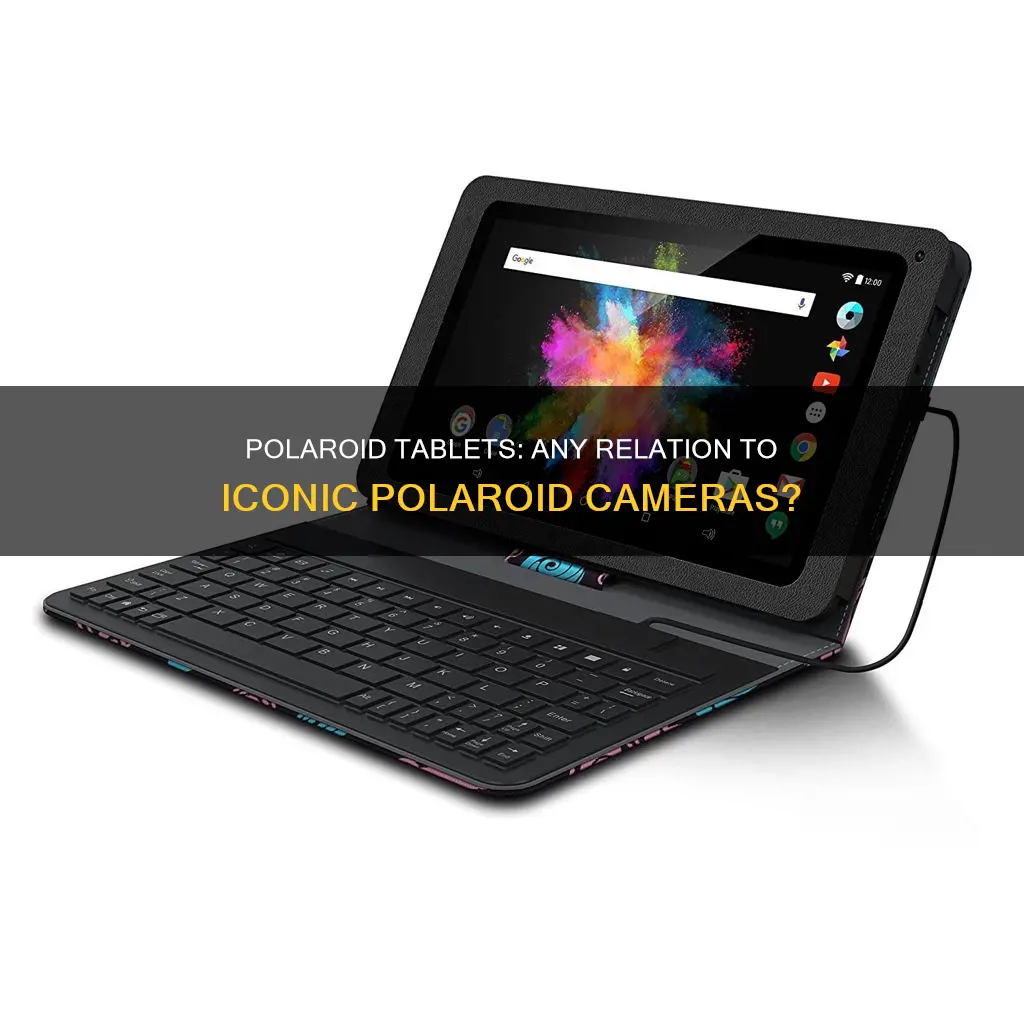
The Polaroid Corporation was an American company best known for its instant film and cameras. It was founded in 1937 by Edwin H. Land, who also invented the first commercial instant camera, the model 95 Land Camera, in 1948. The company has since expanded its product line to include tablets, such as the Polaroid PMID4312 4.3 Android Jelly Bean Tablet, which features a front camera and Wi-Fi capabilities. While the original Polaroid Corporation filed for bankruptcy in 2001, the brand has survived and continues to be used for various consumer electronics, including instant cameras and tablets.
What You'll Learn

Polaroid Tablets: Features, Pros and Cons
Polaroid has been licensing its brand to a tablet maker, Brooklyn-based Southern Telecom, since 2012. The company has released several models, including two kids' tablets. Polaroid tablets are Android-based and come in 7-inch and 10.1-inch sizes.
Features
Polaroid tablets have multi-touch capacitive touch screens and are equipped with front and rear cameras, although the quality of the cameras is not exceptional. They have a micro-SD card slot, a mini-USB port, a headphone jack, and a full-size USB port. The tablets run on the Android Ice Cream Sandwich operating system and have easy-to-use parental controls for kids' tablets.
Pros
Polaroid tablets are generally affordable and easy to use, especially for those new to the computing world. They are sturdy and have good battery life, with one user reporting that the battery lasted well during extensive tests. The tablets are lightweight and have a responsive screen. The parental controls on the kids' tablets are easy to set up, and the tablets come with a range of pre-loaded kid-friendly apps and content.
Cons
The main issues with Polaroid tablets seem to be related to performance, with some users reporting slow processors, poor screen resolution, and frequent response lags. The tablets are also bulkier and thicker than average, and there are concerns about the placement of the card slot and ports, which are exposed and not protected by rubber caps. Additionally, some users have reported issues with installing Google Play and connecting to Wi-Fi.
Where's the Adjustment Brush? Camera Raw's Essential Tool
You may want to see also

Polaroid's History: From Instant Cameras to Tablets
The Polaroid Corporation was founded in 1937 by Edwin Land, who is recognised by most as the father of instant photography. The company was born out of Land's self-guided research in light polarisation, which led to the creation of polarised sunglasses.
During World War II, Polaroid designed and manufactured products for the armed services, including an infrared night-viewing device. In the years following the war, the growth of the American economy allowed new industries to flourish, including instant photography. The first Polaroid camera was put on sale in 1948. This camera still relied on the photographer to time the development of the film, pull out the print, burst a pod of developing chemicals, and peel away the top film.
Over time, instant camera technology progressed, and by the 1970s, Polaroid held two-thirds of the instant camera market, despite competition from Kodak. In 1972, Polaroid introduced the SX-70 camera, which ejected the print automatically.
However, in the late 1970s, sales of instant cameras began to decrease as video cameras and 35-millimetre cameras became smaller and cheaper. Ultimately, Polaroid's innovations in instant photography led to its own demise as digital photography took over.
Polaroid Corporation was declared bankrupt in 2001, and its brand and assets were sold off. The company changed hands multiple times before being acquired by Polish billionaire Wiaczesław Smołokowski in 2017. Today, the Polaroid brand survives as a consumer electronics company, offering products such as tablets, LCD televisions, and DVD players.
While Polaroid no longer produces instant cameras, a group of former employees bought a Polaroid film factory in the Netherlands and formed a company called The Impossible Project, which continues to produce instant film materials for vintage Polaroid cameras.
Eco Mode: Camera's Power-Saving Feature
You may want to see also

Polaroid PMID4312 Tablet: Customer Reviews
The Polaroid PMID4312 tablet has received mixed reviews from customers on Amazon. While some customers have given it a rating of 5 stars, others have given it a rating of 1 star.
Positive reviews mention the tablet's convenient size for travel, ease of use, and affordable price. One review states, ""This is a nice little tablet. Not expensive and [a] great size to pack up and take on trips. Easy to use."
However, negative reviews highlight issues with the tablet's performance, speed, battery life, and size. Several customers have complained that the tablet is slow, freezes frequently, and has poor battery life. One review mentions, "I bought two of these for my young boys and it doesn't do much. There's just not enough to it to play any games, it freezes on videos and only stays charged for about 45 minutes."
Other customers have expressed disappointment with the size of the tablet, stating that it is smaller than expected and should not be considered a tablet due to its compact dimensions.
Overall, the Polaroid PMID4312 tablet has received mixed feedback, with an average rating of 3.5 stars out of 5 on Amazon. While some customers appreciate its portability and affordability, others have been disappointed with its performance, speed, and battery life, suggesting that it may not meet the needs of those looking for a more powerful or versatile device.
Camera Battery Care: How to Know if It's Dead
You may want to see also

Polaroid Tablets: Current Models and Prices
Polaroid is a well-known consumer electronics brand that offers a range of tablet options, including both new and pre-owned models. Here is an overview of some of the current models and their features:
Polaroid Platinum Series:
- Platinum 7" 3G+TV: Features a 7-inch display with a resolution of 1024 x 600. It runs on the Android 4.1 Jelly Bean operating system.
- Platinum 7.85": This model has a 7.85-inch display and runs on Android 4.2 Jelly Bean.
Other Polaroid Tablets:
- Polaroid Executive Clavier 8: Runs on Android 4.2 Jelly Bean.
- Polaroid NEON 7" Kids: Designed for kids, this tablet has a 7-inch display and runs on Android 4.2 Jelly Bean.
- Polaroid Executive 13.3: Features a large 13.3-inch display with a resolution of 1280 x 800. It runs on Android 4.1 Jelly Bean.
- Polaroid Executive 9.7: This model has a 9.7-inch display with a resolution of 1024 x 768. It runs on Android 4.1 Jelly Bean.
- Polaroid Diamond 3G+: Features a 7-inch display with a resolution of 1024 x 600. It runs on Android 4.0 Ice Cream Sandwich.
Polaroid Tablet Prices:
While specific prices for the above models are not readily available, Polaroid tablets can be found on various online marketplaces, such as eBay and Amazon. The prices vary depending on the model, condition, and specifications. For example, on eBay, pre-owned Polaroid tablets range from $14.95 to $139.99. On Amazon, a pre-owned Polaroid 10.1-inch tablet was previously available for an undisclosed price, but customer reviews indicate that it was affordable and a great value for the price.
It is always a good idea to check multiple retailers and compare prices to find the best deal when purchasing a Polaroid tablet or any other electronic device.
Unlocking Camera Raw: Beyond 100 Presets
You may want to see also

Polaroid Tablets vs Polaroid Cameras: Similarities and Differences
Polaroid, a brand that has become synonymous with instant photography, has expanded its product line to include tablets. While both Polaroid tablets and Polaroid cameras serve as electronic devices for content consumption and creation, there are several similarities and differences between the two product categories.
Similarities:
One of the main similarities between Polaroid tablets and Polaroid cameras is their association with the Polaroid brand, which is known for its innovative and user-friendly approach to photography. Both products also fall under the broader category of consumer electronics, offering digital solutions for capturing and viewing content. Additionally, both Polaroid tablets and cameras are designed with portability in mind, allowing users to take them on the go.
Differences:
The most significant difference between Polaroid tablets and Polaroid cameras lies in their primary functions. Polaroid cameras are specialized devices designed specifically for capturing photographs and, in some models, printing them instantly. On the other hand, Polaroid tablets are general-purpose computing devices that offer a range of functionalities, including web browsing, multimedia consumption, and basic productivity tasks, in addition to capturing photos and videos.
Another key difference is the level of versatility offered by each device. Polaroid cameras are typically designed with a specific purpose in mind, such as instant photography or action photography, and their features are tailored accordingly. In contrast, Polaroid tablets provide a broader range of features and capabilities, allowing users to install various apps and customize their devices to suit their specific needs.
Polaroid tablets and cameras also differ in terms of interactivity and user experience. Polaroid cameras often prioritize simplicity and ease of use, with intuitive controls and point-and-shoot functionality. Polaroid tablets, on the other hand, offer a more comprehensive user interface, enabling users to interact with a variety of apps and perform multiple tasks.
In terms of hardware, Polaroid cameras are designed around an optical system that includes lenses, sensors, and, in some cases, built-in printers. Polaroid tablets, on the other hand, incorporate displays, processors, storage, and other computing components that are more similar to those found in other tablet devices on the market.
Lastly, the target audience for Polaroid tablets and cameras can vary. While Polaroid cameras often appeal to a wide range of users, from casual photographers to professionals, Polaroid tablets may be more geared towards those seeking a general-purpose device for everyday use, entertainment, or light productivity tasks.
In conclusion, while both Polaroid tablets and Polaroid cameras share some similarities in terms of brand association and portability, they differ significantly in their primary functions, versatility, user experience, hardware, and target audience.
Shutter Mode Simplified: Easy Steps for Canon Cameras
You may want to see also
Frequently asked questions
No, the Polaroid tablet is not made by the Polaroid camera. The Polaroid Corporation, an American company known for its instant film and cameras, has expanded its brand to include consumer electronics such as tablets.
The Polaroid Corporation was founded in 1937 by Edwin H. Land and is recognised for pioneering the first instant camera and film. The company has since expanded its product line to include various consumer electronics, with the brand changing hands multiple times after facing bankruptcy in 2001.
The original Polaroid Corporation filed for bankruptcy in 2001 due to the rise of digital photography and changes in the market. The brand and assets were sold, and the company underwent several ownership changes before being acquired by Polish billionaire Wiaczeslaw Smołokowski in 2017.
Polaroid now offers a range of consumer electronics, including tablets, LCD televisions, DVD players, digital cameras, portable printers, and instant cameras and film.
Customer reviews of Polaroid tablets are mixed. Some users have criticised the speed, performance, battery life, and size of the tablets, while others have found them to be good value for the price. It's important to research specific models and their features before making a purchase decision.







